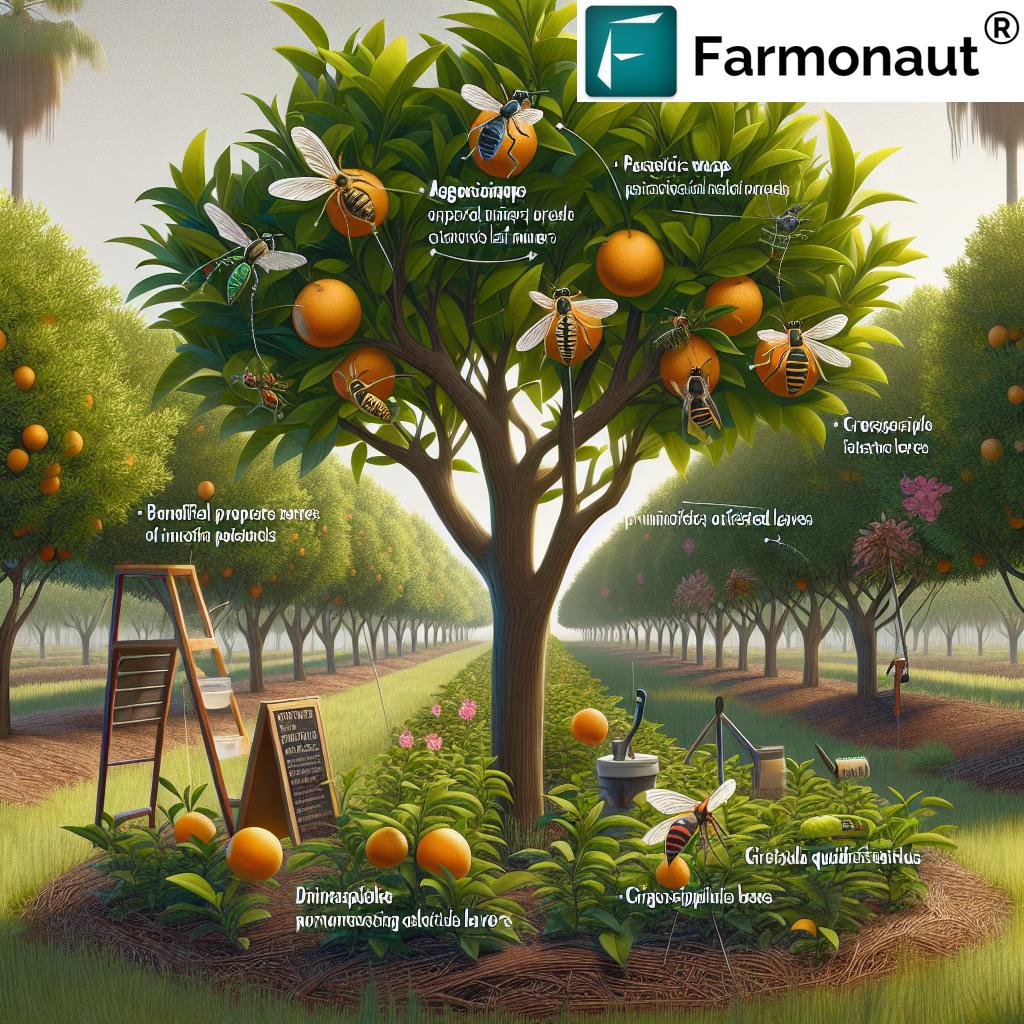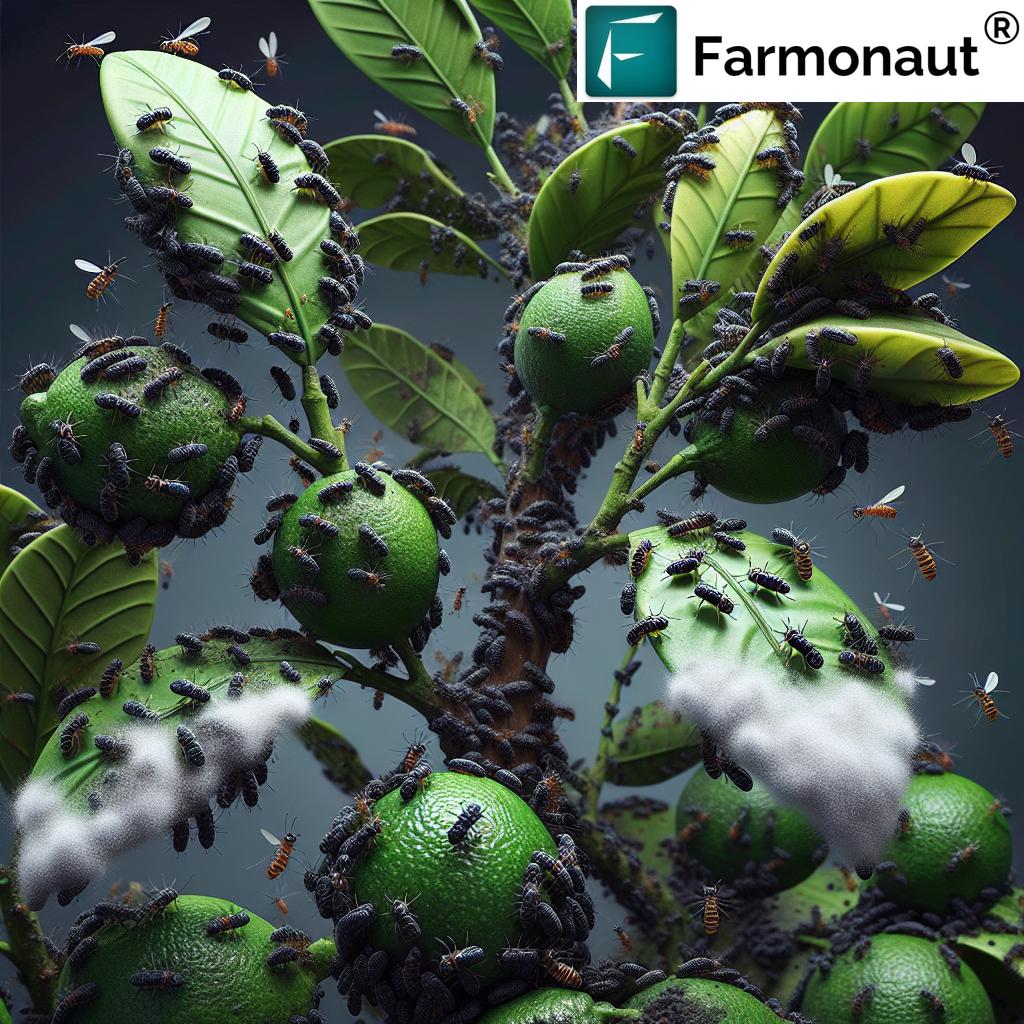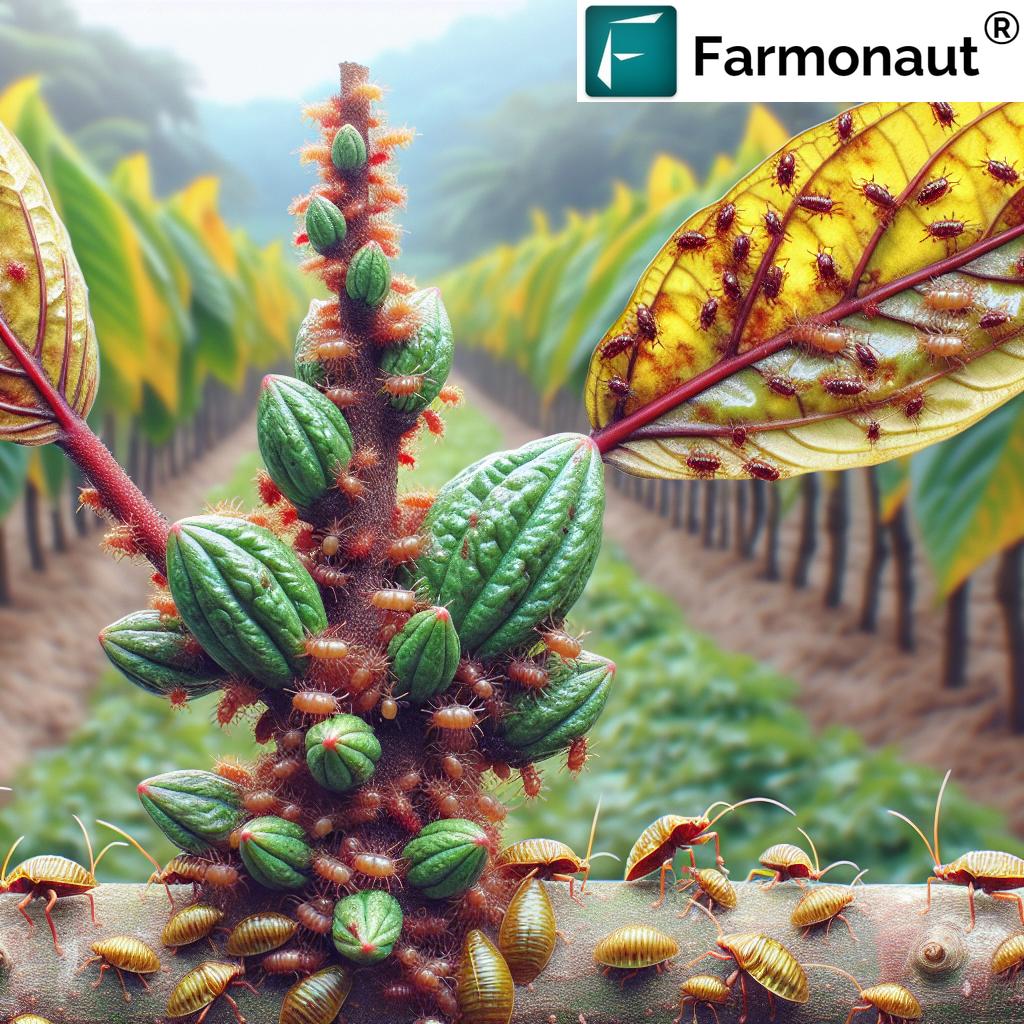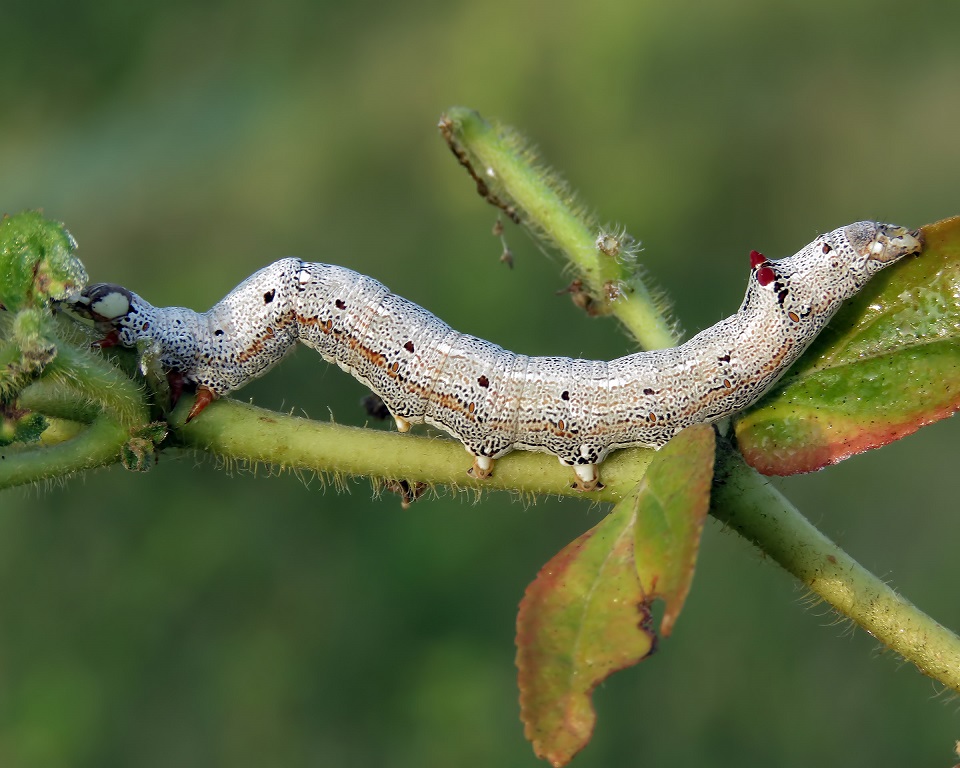Leafminer Control Citrus: 7 Proven Methods for Healthy Trees
“Over 90% of citrus yield loss can be prevented by implementing 7 proven leafminer control methods.”
Table of Contents
- Introduction
- Understanding the Citrus Leafminer
- Citrus Leaf Miner Damage Symptoms
- Method Comparison Table
- Cultural Control Methods for Leaf Miner Prevention
- Biological Control of Citrus Leafminer
- Chemical Control Methods
- Integrated Pest Management for Citrus
- Leveraging Technology: Precision Citrus Pest Management with Farmonaut
- Farmonaut App, API & Solutions for Citrus Growers
- FAQ: Leafminer Control in Citrus Trees
- Conclusion
Introduction
Citrus trees are key to global agriculture, embodying health, flavor, and economic significance for farming communities in the United States, Asia, and every important citrus-producing region worldwide. However, one significant pest threatens the yields, fruit quality, and long-term health of these trees: the citrus leafminer (Phyllocnistis citrella).
Leafminers, particularly in citrus, are notorious for the serpentine mines their larvae create in young leaves. These mines disrupt photosynthesis, cause distortion of leaves, and provide entry points for secondary pathogens such as those responsible for citrus canker. Severe infestations can result in premature leaf drop, reduced tree vigor, and decreased fruit yield and quality.
As responsible stewards of citrus orchards, it’s our job to implement effective pest control in citrus trees. In this comprehensive guide, we delve into proven citrus leafminer management strategies, explaining cultural, biological, and chemical control methods. You’ll discover how to get rid of leaf miners using integrated pest management (IPM) and natural ways to control leaf miners—ensuring your citrus trees remain robust, healthy, and productive.
Understanding the Citrus Leafminer (Phyllocnistis citrella)
The citrus leafminer is a small moth, native to Asia but now established in citrus-growing regions worldwide—notably in the United States, the Mediterranean, Australia, South America, and Africa. Its presence in groves signals a challenge common among citrus growers everywhere.
- Adult Moth: Tiny, about 2-3 mm long, with silvery wings marked by black and brown.
- Eggs: Minute, usually laid singly on the undersides of tender leaves—the fresher the flush, the more attractive to moths.
- Larvae: Hatch and immediately burrow into the leaf tissue, creating winding, serpentine mines. These tunnels are visible as silvery tracks on leaves.
- Pupae: The larvae pupate inside the mine, emerging later to repeat the cycle.
Multiple overlapping generations can occur in one growing season, particularly when young foliage emerges in flushes.
Citrus Leaf Miner Damage Symptoms
- Serpentine Mines: Curved, silvery trails visible on surface of new leaves.
- Leaf Distortion: Leaves often curl or twist as larvae feed and grow.
- Premature Leaf Drop: Particularly heavy infestations may cause leaves to fall prematurely, reducing photosynthetic capacity.
- Reduced Vigor: Trees with ongoing infestations lose energy, appear weaker and yield less fruit of lower quality.
- Secondary Infection Risks: Mines serve as entry points for pathogens, leading to diseases such as citrus canker.
As we can see, the impact of leaf miner damage isn’t merely cosmetic; it can cause severe damage and long-term decline in citrus orchards if not addressed promptly with robust citrus leafminer management.
Method Comparison Table: 7 Proven Leafminer Control Methods
Selecting the right combination of citrus pest management strategies is easier with this comparative table. We compare the most effective leaf miner control methods by their mechanisms, estimated impact, cost, and timing—allowing you to create an informed, robust integrated pest management for citrus.
Cultural Control Methods for Leaf Miner Prevention
1. Fertilization Timing and Application
Cultural practices are cornerstone strategies in citrus leafminer management. Proper fertilization timing can significantly reduce the pest’s breeding sites:
- Apply fertilizers in late winter: Promotes strong growth in spring, when leaf miners are less active. This helps our trees develop resilience before the pest’s population peaks.
- Limit fertilizers in late summer and autumn: Reduces the flush of young, tender leaves that leafminers love, restricting their access to ideal egg-laying sites.
Smart fertilization practices lead to robust, balanced trees—which naturally helps defend against citrus pests.
- Interested in integrating smart fertilizer and pest timing recommendations with real-time crop health monitoring? Explore the Farmonaut API and Developer Docs for automation and precision agriculture solutions.
2. Pruning & Regular Removal of Infested Leaves
Vigilant pruning and sanitation are essential for how to get rid of leaf miners:
- Regularly inspect trees for mined or curled leaves, especially on young shoots.
- Remove and destroy infested leaves during peak activity (new growth flushes). Never leave prunings on the ground as these can harbor larvae.
- Improve air circulation by thinning overlapping branches, reducing humidity and making the microclimate less favorable for pest development.
By lowering the population base, we can reduce future infestations and strengthen overall tree health.
3. Water Management: Preventing Excessive Growth
Overwatering, especially during late summer and autumn, encourages flushes of young leaves—prime territory for leaf miner infestation. Crucial tips:
- Adjust irrigation schedules to tree needs and climatic conditions.
- Avoid excessive watering during late-season warm weather, which stimulates soft leaf production.
- Monitor soil moisture to prevent waterlogging as it can stress trees, making them more attractive to pests.
By following these steps, we can maintain healthy trees and discourage leafminers naturally.
“Biological control can reduce citrus leafminer populations by up to 60% when integrated with cultural practices.”
Biological Control of Citrus Leafminer: Harnessing Natural Predators and Parasitoids
4. Parasitic Wasps: The Power of Ageniaspis citricola & Cirrospilus quadristriatus
One of the most environmentally friendly and sustainable solutions is using natural parasitoids—especially certain wasp species. Here’s why:
- Parasitic wasps lay their eggs inside or on leafminer larvae, specifically targeting Phyllocnistis citrella. Their offspring consume the pest larvae, killing them before they can mature.
- Ageniaspis citricola and Cirrospilus quadristriatus are two species widely documented for their impact in reducing pest populations by up to 60% when in synergy with other methods.
- Release or protect these wasps by minimizing broad-spectrum insecticide use—they are susceptible to chemical disruption.
Building shelters or maintaining diverse flowering plants nearby encourages beneficial insects and natural ways to control leaf miners.
-
Want to enhance your orchard’s overall sustainability profile?
Learn how carbon footprint tracking with Farmonaut can help you monitor agro-environmental impact as you adopt biological and cultural pest management.
5. Predators: Lacewings, Ants, and Spiders
A balanced orchard ecosystem supports predators that naturally suppress leafminer populations:
- Lacewing larvae, ants, and spiders feed on leafminer larvae and eggs.
- To attract these allies, minimize use of disruptive chemicals and provide a garden or orchard understory with mulches, ground covers, or flowering species.
Integrating predator support with other biological controls offers robust, sustainable pest control in citrus trees.
Chemical Control Methods: When and How to Use Insecticides for Citrus Leafminer
6. Systemic & Foliar Insecticides: Targeting Leaf Miner Larvae with Caution
- Systemic insecticides like imidacloprid or thiamethoxam can be applied via soil or irrigation, helping control larvae feeding inside the leaves. Most effective for young, non-fruiting trees.
- Foliar sprays (e.g., diflubenzuron) must be timed carefully to coincide with peak egg-laying or newly hatched larvae. Multiple applications often necessary.
- Always avoid spraying during peak activity of beneficial insects and follow label restrictions to protect pollinators and natural enemies.
While chemical controls can be effective in severe cases, they should be part of an integrated strategy and not the sole reliance.
- For more robust, multi-layered protection, consider risk mitigation tools from Farmonaut that monitor crop health for early pest warning, essential for insurance and crop loans.
7. Horticultural Oils: Natural and Targeted Leafminer Deterrence
Mineral (horticultural) oils create a protective film over leaf surfaces, which:
- Repels adult moths from laying eggs on young leaves.
- Suffocates early-stage larvae and eggs already deposited on leaves.
- Is less toxic to natural predators and parasitoids, preserving the ecological balance.
Oils should be sprayed just before or during the flush of new growth and reapplied after heavy rain for lasting effectiveness. These are among the best natural ways to control leaf miners, especially for home orchards or organic citrus groves.
Integrated Pest Management for Citrus: Combining Methods for Maximum Impact
The most sustainable and effective approach is Integrated Pest Management (IPM), which combines cultural, biological, and chemical strategies tailored to your orchard’s needs.
-
Monitoring:
- Regularly inspect trees for mines, curling, and leaf distortion.
- Consider using Farmonaut’s satellite-based crop health monitoring to detect early stress and subclinical pest impact, enabling proactive measures. Learn more about large-scale farm monitoring here.
-
Thresholds:
- Set clear action thresholds (e.g., visible mines on more than 25% of young leaves) to decide when to escalate controls.
-
Control Implementation:
- Prioritize integrated strategies that reduce pest populations and preserve beneficial insects.
-
Evaluation:
- After each intervention, assess the decrease in mines and overall tree health, adjusting practices with each crop cycle for continuous improvement.
Leveraging Technology: Precision Citrus Pest Management with Farmonaut
Technology revolutionizes how we view citrus pest management strategies. Farmonaut delivers satellite-based crop health monitoring and AI-powered insights, elevating our ability to detect, predict, and respond to pest threats before they devastate orchards.
- NDVI and Multispectral Imaging: Track subtle changes in leaf health, revealing pest damage before it becomes visible to the naked eye.
- AI Advisory (Jeevn): Get tailored, real-time recommendations for pest management, fertilization timing, and irrigation, ensuring interventions—biological, chemical, or cultural—are perfectly timed.
- Traceability: With Farmonaut traceability solutions, growers provide transparent, blockchain-backed proof of their sustainable pest management practices—creating extra value for conscious export markets.
With Farmonaut, you optimize every stage of orchard management for healthy, high-yield citrus trees while protecting the environment—and your bottom line!
Farmonaut App, API & Solutions for Citrus Growers
-
Mobile-First Access: Use Farmonaut’s Android and iOS apps for on-field monitoring, alerts, and instant satellite-derived advisory updates.
Get started now! - Fleet & Resource Management: For large orchards, Farmonaut’s fleet management improves vehicle/machine organization, reducing operational costs and supporting timely pest management operations at scale.
- Scalable Farm Management: From smallholder to enterprise, Farmonaut’s large-scale farm management tools enable you to quickly scan, analyze, and strategize interventions for thousands of citrus trees.
FAQ: Leafminer Control in Citrus Trees
-
Q: How do I identify citrus leafminer infestations early?
A: Look for winding or serpentine mines on young leaves and subtle leaf distortion. Satellite-based NDVI changes, as offered by Farmonaut, can also indicate early stress. -
Q: Are all citrus varieties equally susceptible to leafminers?
A: Young, vigorously growing citrus trees with frequent flushes are more vulnerable. Some rootstock-scion combinations show more resistance—selecting tolerant varieties can help. -
Q: Are biological controls safe for pollinators and the environment?
A: Yes. Parasitic wasps and predators target only the pest and do not disrupt pollinators or natural ecological balances, unlike many chemical controls. -
Q: How often should I apply horticultural oils?
A: Begin before a new leaf flush and repeat as needed—typically every few weeks—especially after heavy rainfall or with ongoing pest pressure. -
Q: Can I integrate Farmonaut analytics into my existing orchard management software?
A: Yes. The Farmonaut API and
developer docs offer seamless integration of satellite crop health and pest advisory features into your workflow. -
Q: What is the most effective way to reduce dependence on chemical insecticides?
A: Adopt a multi-layered strategy with cultural, biological, and targeted chemical methods. Use real-time monitoring to guide timely, minimal interventions.
Conclusion: Healthy Citrus Trees Through Proven, Integrated Leafminer Controls
The citrus leafminer presents a significant, worldwide threat to citrus health and productivity, but combined cultural, biological, and chemical controls can mitigate its impact. From fertilization timing and pruning to supporting natural predators and deploying modern precision agriculture solutions from Farmonaut, we can outmaneuver this pest sustainably.
We encourage all growers to utilize a holistic, integrated pest management for citrus—monitor, assess, and respond promptly using the latest in farm intelligence and best cultural practices for leaf miner prevention. Let’s work together to maintain strong, productive orchards and ensure a future of healthy, abundant citrus harvests.


















